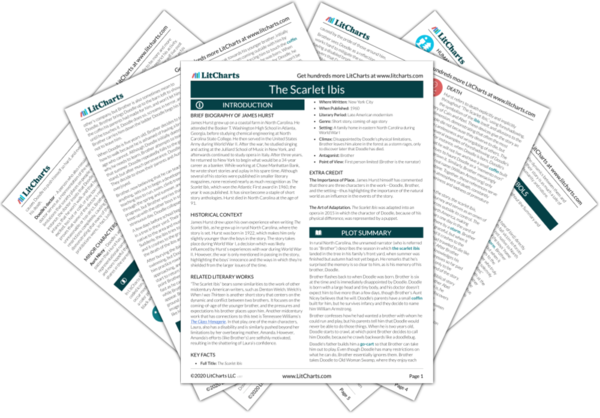Expectations and Disappointment
The primary conflict of “The Scarlet Ibis” surrounds Doodle’s disability and how he works to overcome it with the help of Brother. The way in which Hurst presents Doodle’s journey, however, demonstrates that Doodle’s biggest challenges often arise not from his actual disability, but instead from the judgment and pressure he experiences from different people in his life. Brother admits that when Doodle was born, he saw him as a “disappointment” because he…
read analysis of Expectations and DisappointmentPride
Brother takes pride in Doodle’s achievements, and this sense of pride becomes a major motivation for his actions throughout “The Scarlet Ibis.” He gradually acknowledges that he only helps his brother out of a sense of pride, and that this pride leads him to behave selfishly. Other characters, such as Doodle’s parents, also find pride in Doodle’s accomplishments and hard work, spurring Doodle to work harder and harder to please his family. Hurst’s…
read analysis of PrideDeath
Hurst refers to death explicitly and implicitly throughout “The Scarlet Ibis,” using foreshadowing, the symbolism of the ibis itself, and allusions to the Biblical story of Cain and Abel. These devices give the story an allegorical dimension, demonstrating that often the most innocent people die not because they deserve to die, but because of the carelessness and wrongdoing of others. The story contains several examples of foreshadowing of Doodle’s untimely death. For instance, when Doodle…
read analysis of Death
Humans and Nature
“The Scarlet Ibis” is filled with many rich descriptions of the natural world. It quickly establishes the rural North Carolina farmland in which the story takes place and draws some of its most important symbols from nature. Beyond providing a detailed vision of the story’s setting, however, Hurst uses descriptions of nature and the seasons to mirror the boys’ states of mind as well as the dynamic between them, and to suggest that, like nature…
read analysis of Humans and Nature






